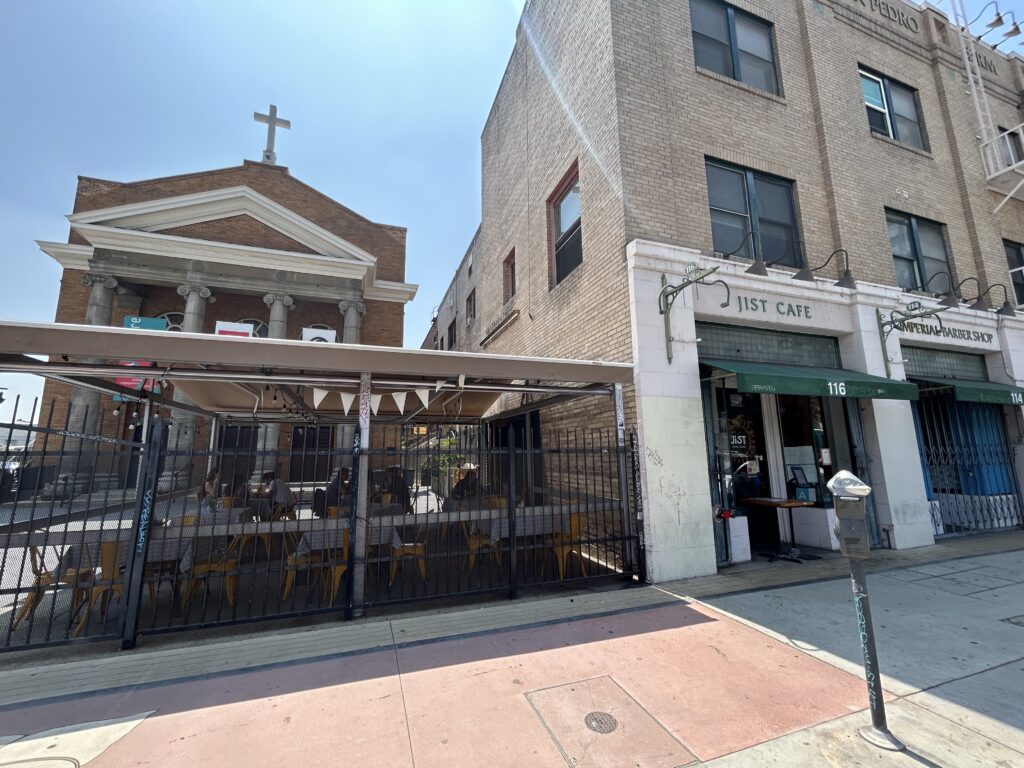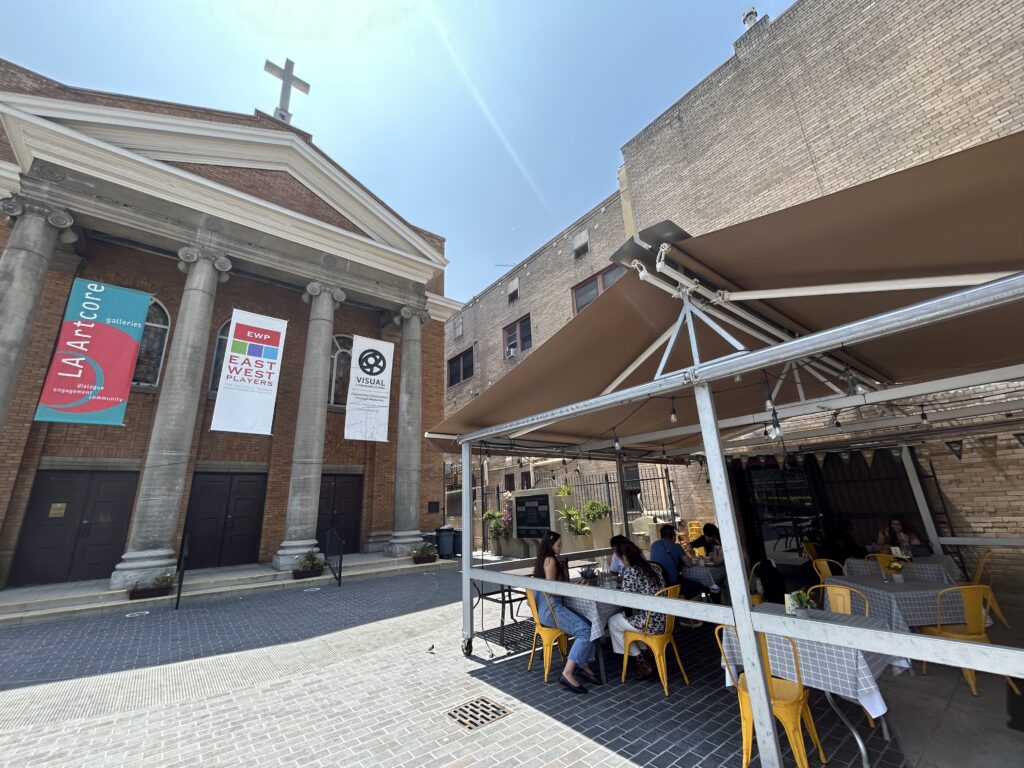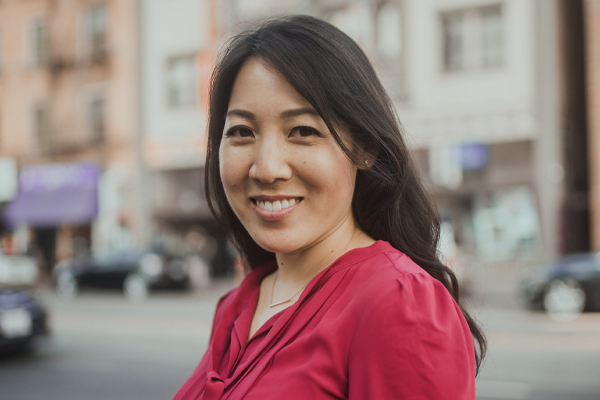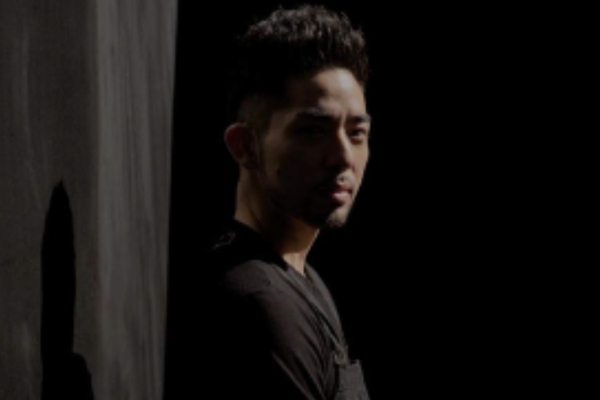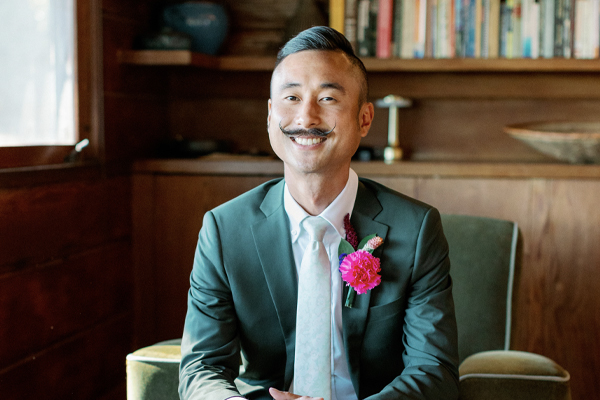Who we interviewed with……
Mr. Glen Ishii
Born and raised in Little Tokyo and Arcadia. He enjoys looking for great things to eat which inspires him to cook something inspirational. He opened a brunch restaurant so that he can balance his restaurant life with his family life. His hobbies are the restaurant business, cooking and golf.

“OMOSHIROSA” was his keyword in this interview. This Japanese word can be translated into “fun,” “excitement,” “interest,” or even “unique.”
Mr. Glen Ishii’s grandmother, the owner of JiST Cafe, started a restaurant called the Tokyo Café on Wheeler Street in 1920. In the 1970s, the restaurant moved to 2nd Street and became known as The Tokyo Gardens. Ishii started JiST Cafe in 2013. The name of the cafe is his then-partner’s mother’s initials, J and S, and his mother’s initials, I and T.
Growing up seeing his grandmother and mother own a restaurant, he wanted to become a chef. He began his career at his grandmother’s restaurant, chopping vegetables and doing other prep work, and when he got a little older, he was allowed to wash dishes. His mother eventually taught him how to cook.
At the time, most restaurants were like coffee shops. He says they were open for breakfast, lunch, and dinner and were crowded with many Japanese and Japanese Americans.
When Ishii was a kid, there were many Japanese businesses, so Japanese customers were coming in to dine at his family’s restaurant. The Little Tokyo area was pretty safe until the riots happened, which made the town empty, like a ghost town. Then around 2005, he says, people of all different races started coming in to dine, not just Japanese and Japanese Americans.
People from different cultures and backgrounds started to gather together in Little Tokyo. He attributes this radical change as a turning point that makes the town more vibrant. “If you target only Japanese and Japanese-Americans, a lot of people would stop coming,” he said. The reason why he said so is because many Japanese and Japanese Americans were moving to Torrance, San Gabriel valley, and Orange County to leave Little Tokyo.
When we asked him why he chose Little Tokyo to open a café when he could have chosen other locations, such as Torrance, San Diego, or where he mentioned, he gave us a very interesting answer.
“Because Little Tokyo only had sushi restaurants and Ramen restaurants at the time, I thought the Americans and Asian Americans living here needed something different. So I opened a brunch restaurant, JiST Cafe, for everyone who comes to Little Tokyo.”
JiST Café is only open Wendsday-Friday 8 am-1:30 pm, and Saturday and Sunday 9 am-2 pm. They don’t serve a traditional Japanese breakfast such as white rice and miso soup. Ishii explains the reason for this, “I don’t mean to be rude, but it’s just not interesting. I’m Japanese-American and I love Japanese food, but I get bored if I cook Japanese food every day.”
Ishii was raised as a third-generation Japanese American. Growing up, he loved both American and Japanese food. Thus, what he came up with was to mix American food with Japanese food and food from other Asian countries.
This brand-new and one-of-a-kind cuisine was “something” he felt was missing from Little Tokyo. For him, Little Tokyo with only Japanese food would be boring.
Little Tokyo is the place where the JiST Cafe has been building its history and precious memories since when it all started in his grandmother’s time. On the other hand, Ishii is considering leaving Little Tokyo to focus on his family and expand his business.
But wherever the location is, his desire for their restaurant is to create an atmosphere that makes customers feel at home when they enter the store. Ishii says he wants his customers to feel nostalgic and remember the taste they have tasted before with his food.
These words make a lot of sense coming from Ishii. At his restaurant, you would, indeed, find an “OMOSHIROSA” from Japanese, American, and Asian fusion cuisine. And what he serves symbolizes the environment in which he grew up.
A chef communicates with one through cooking. He always keeps that in mind when cooking.
Furthermore, what. Ishii values as a chef is not to copy. Copying is not what a real chef does.
There was a very popular “Chashu Shumai Combo,” which his grandmother and mother were serving at their restaurant.
He wanted to bring this menu into his restaurant, but he didn’t want to just straight up copy it. So he decided to take a little inspiration from the dish and create his original menu item called “Chashu Hash” as a brunch menu. By using a chashu instead of corned beef in this hash, he was able to create the perfect mixture of an American and Asian dish.
We recommend you order “Chashu Hash” when you visit the restaurant! Also, don’t forget the pancakes, Ishii’s specialty. He will surely make delicious ones for you.
“I make what I want to eat. I am a cooking fool. I love cooking.” He stated with a shy laugh.
Sometimes, Ishii finds it so difficult to cook that he even thinks he hates it. Each chicken and each fish are different. He has to change the way he cooks so each ingredient can be cooked in the best way. Vegetables, such as carrots, can have a different sweetness depending on the one. And some cabbage is sweet, some is watery. That’s the hard part.
But he never ceases to have the desire to make something that he can say, “This dish is perfect.” Even if it is very difficult to create something new, he continues to try everything he can to create something delicious.
Ishii says that deliciousness is not enough and never enough. When we asked him what he is looking for beyond deliciousness at the very end of the interview, you all know his answer by now, don’t you?
It’s “OMOSHIROSA.”
【Special Interview 2023】”Key People” in Little Tokyo

